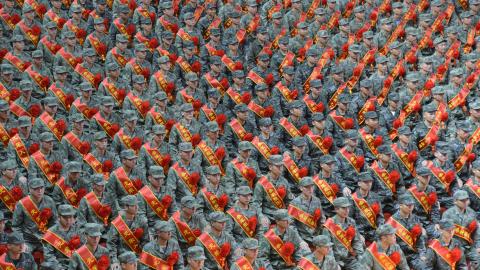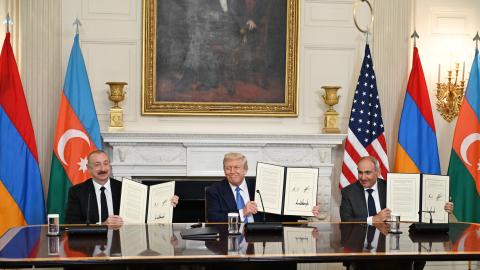World War II analogies are back in fashion. Russia sympathizers accuse NATO of warmongering, comparing tank donations to Ukraine with Hitler’s invasion of the Soviet Union, and military planners warn about Pearl Harbor-style surprise attacks in the Pacific. Meanwhile, the other side characterizes those charges in terms of the appeasement policies that allowed the Nazis to spread halfway across Europe before war broke out in earnest.
Therefore, Robert Kagan’s The Ghost at the Feast could not hit the bookshelves at a better time. The second part of a trilogy about American foreign policy, the book covers 1900-1941, the period when the United States became the strongest of the great powers and missed its opportunity to create a durable peace. It was a period when other great powers, in Europe and elsewhere, expected the US to step into a leadership role that it declined. American “policies exacerbated existing problems in Europe and created new ones,” and the human cost of that failure was immense.
The Ghost at the Feast picks up where its predecessor, Dangerous Nation, ends. The US had tremendous latent power, everyone knew it, and—with some exceptions, such as President Theodore Roosevelt—people thought there was little need to exercise that power. In 1900, the cause of universal peace seemed triumphant: American peace organizations nearly outnumbered the rest of the world's, and they cheered on American diplomats who pioneered agreements to settle international disputes through arbitration rather than combat. Humanitarian interventions such as the war to liberate Cuba from Spain were still necessary from time to time, but history, it was thought, was on America’s side.
Unfortunately, World War I falsified President Woodrow Wilson’s prediction of “an age of settled peace.” Each of the powers courted America, and the country was genuinely divided about what to do: German Americans generally supported the fatherland, Irish and Jewish Americans could not stomach fighting on the side of their ancient oppressors (the British and Russians, respectively), the Eastern establishment wanted to help the Allies win, and the Midwest wanted to sell its goods to both sides but otherwise steer clear of the entire imbroglio. Much to Roosevelt’s dismay, Wilson stayed out of the war as long as he could.
When Germany sank American ships in 1917, even Wilson could no longer stay out. The biggest applause line in Wilson’s war speech to Congress was his announcement that Americans would not submit to German diktats, although many people quickly came around to support Wilson’s goal of “making the world safe for democracy.”
Agreeing on how to achieve that goal was a different matter. Wilson was a late convert to the League of Nations idea: Roosevelt and other leading Republicans had proposed similar arrangements, and British Foreign Secretary Edward Grey talked Wilson into supporting the league. At the peace conference, Wilson had to concede many of his war aims, but he hoped that the league would eventually remedy those defects. Unfortunately for him, the vote over whether to sign the league treaty failed in the Senate 38-53, and a watered-down version fell seven votes short of the needed two-thirds majority. Kagan argues that the anti-league publicity campaign paved the way for “irreconcilables,” such as progressive isolationist Republican William Borah, to take over the GOP.
This doomed the postwar order. British diplomat Harold Nicolson later recalled “the ghastly suspicion that the American people would not honor the signature of their own delegates” had been “the ghost at all our feasts” during the negotiations. As Kagan puts it, “The treaty was never intended to be implemented without the United States, and it could not be.” With an active America, “the crisis in Europe could possibly have been managed,” but “without continued American involvement, it was only a matter of time before Germany regained its hegemonic position on the continent.” Britain and France were just too weak to keep dissatisfied powers at bay on their own.
But for a time, the problem did not come up. The Harding, Coolidge, and Hoover administrations returned to the blithe optimism of the prewar era. Their primary goals for Europe were to ensure the Allies paid off their wartime loans, keep the continent open for American trade and investment, negotiate arms control treaties, and otherwise stay out. The Allies, which struggled under the massive debt load, squeezed the Germans for reparations, and France occupied the Ruhr to force a recalcitrant Germany to pay up. Eventually, even Borah feared that economic instability in Europe would harm the US economy, and American bankers with unofficial government backing negotiated a series of agreements to paper over European economic problems. Those maneuvers, along with some naval disarmament treaties and the “outlawry” movement to make war illegal, kept American diplomats occupied during the Roaring '20s.
Trouble was already brewing. Kagan notes that “it is customary to focus on the collapse of world order in the 1930s,” but he argues that “it was in the 1920s that peace was truly lost.” At first, Germany borrowed freely from Americans to fuel its economic recovery, but Wall Street’s high yields diverted investors, and Germany’s economic bubble burst. American protectionism alienated Japan, whose liberals gradually lost power to the militarists amid a series of economic downturns. After the 1929 stock market crash, Americans turned inward, and the Germans and Japanese turned fascist.
After mismanaging the '20s, the American intellectual class abjectly failed in the face of the Depression’s much greater challenges. Kagan mostly trains his fire on Republicans, academic realists, and progressives such as Borah. But the problem was more wide-ranging than that. Many liberals spent much of World War I arguing that the fate of Western civilization depended on Germany’s defeat but also that the US should stay out of the war. Their postwar ideas were barely more serious. As the communists and fascists grew stronger in Europe, a significant portion of the American intelligentsia argued about which of the two movements would replace democracy and why the US should do as little as possible to stop them.
The world was turning darker as Franklin Roosevelt came into office. Japan had already seized Manchuria, and Hitler had gained control of Germany. As Japan attacked China, Italy invaded Ethiopia, and the fascists gained the upper hand in the Spanish Civil War, Roosevelt had few domestic allies. Initially, he depended on Republican progressives such as Borah to deliver the New Deal and thus had little room for maneuvering abroad, but gradually, he cobbled together a coalition of old-stock “Anglo-Saxon” Americans, the Eastern establishment, Jews, and Southerners to stand up to the totalitarians. Hitler’s evil helped: Kristallnacht and other vicious incidents of antisemitism largely turned American public opinion against Germany.
The Americans were almost too late. The Navy was so understrength by Hoover’s administration that an attempted show of force against Japan just underscored American weakness, and for years, the public had no interest in remedying this problem. The British ambassador in Tokyo wrote home that the Japanese saw “the opportunity of a century for the advancement of Japan’s destinies,” a phrase eerily reminiscent of Chinese President Xi Jinping’s observation that China today is witnessing “Great Changes Unseen in a Century.” More sober Japanese leaders, such as Adm. Isoroku Yamamoto, warned that in a fight with the US, “I shall run wild for the first six months or a year, but I have utterly no confidence for the second or third years.”
By the time war was raging in Europe, Roosevelt and his advisers worried that the Axis powers would avoid bringing the US into the war until after they had knocked out the Allies. After sitting on the sidelines for decades, the Americans prepared to take the field in 1940. Wartime orders from Britain and France had begun to revive the American arms industry, and Congress initiated a massive naval and aerial rearmament after France surrendered. As American ships fought German U-boats in the Atlantic Ocean and American sanctions on Japan began to bite, the Axis powers sped up their timeline. Hitler moved up his plans to try to knock out the Soviet Union, and Japan found itself in a now-or-never moment before the Americans grew too strong. Yamamoto was right: His navy rampaged for a few months after Pearl Harbor, and then, American industry buried Japan and Germany under thousands of ships, hundreds of thousands of planes, and millions of well-armed men.
Much of The Ghost at the Feast is a diagnosis and lamentation of America’s failures during this period, but Kagan bookends it with an important question: What made the Americans fight at all? In 1900, the American economy was largely self-sustaining, and Kagan notes, “The United States did not need foreign trade to flourish.” A Germany-centric Europe and a Japan-dominated “Greater East Asia Co-Prosperity Sphere” would have posed a threat to Americans, but only a possible one.
For Kagan, “the answer had less to do with material national interests such as immediate physical security than with moral and ideological considerations that shaped perceptions of a longer-term threat.” In other words, if World War II “was ‘necessary,’ it was not to protect the American homeland but to defend and restore the kind of liberal order in which Americans preferred to live and which provided the greatest degree of protection against possible future threats.”
Moral and ideological considerations prodded Americans to recognize the threat posed by Germany and Japan but not to fight them. Just as in World War I, the Americans took some steps to aid the Allies but did not commit to full-fledged hostilities until after they were attacked.
Kagan’s second installment shows how the real wonder is not that the Americans joined the fight in 1917 and 1941 but rather that they entered the Cold War without having been directly attacked. If Kagan’s finale is anything like the trilogy’s first two installments, it will provoke, inform, and enliven our debates for years to come.


















